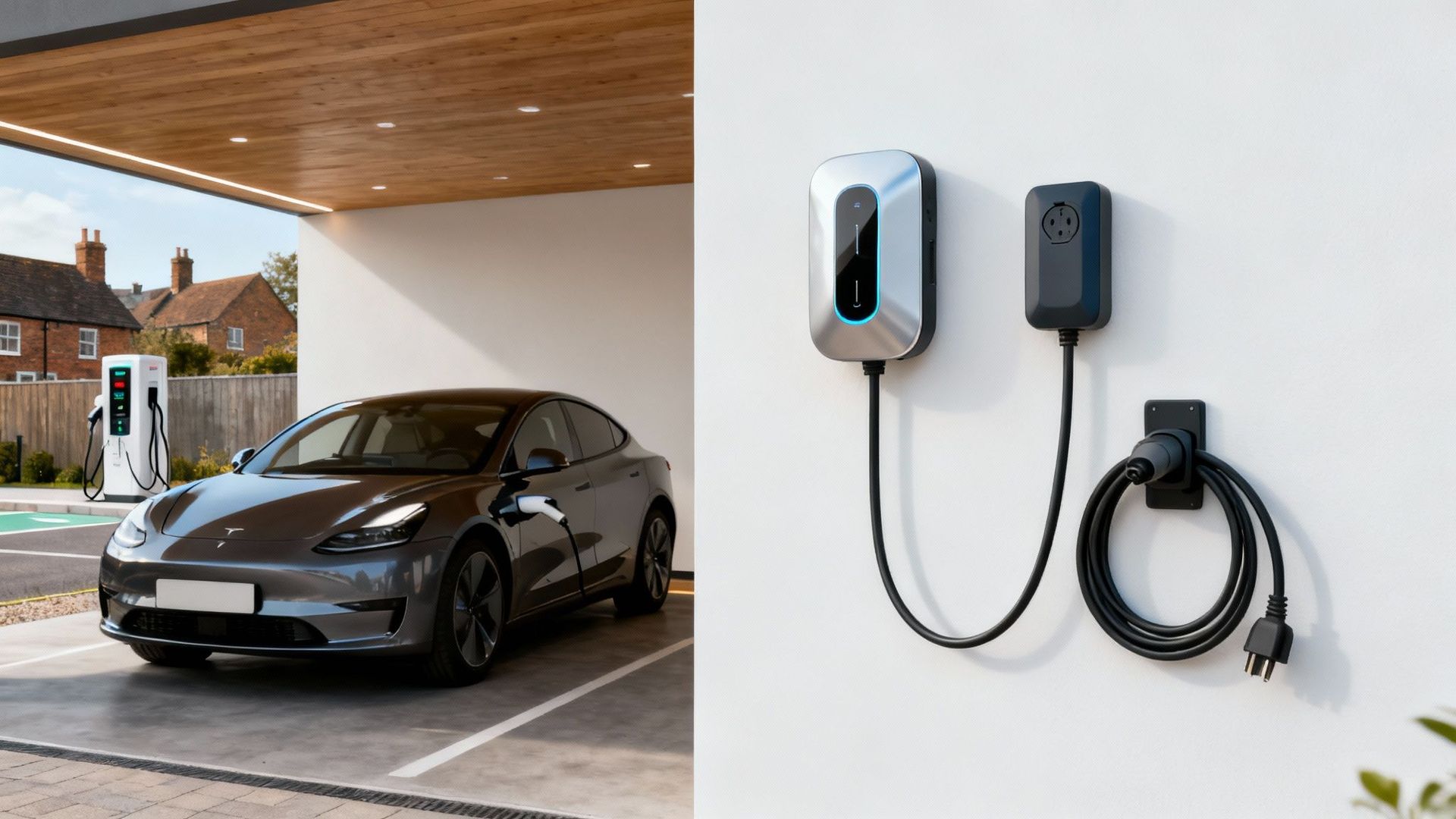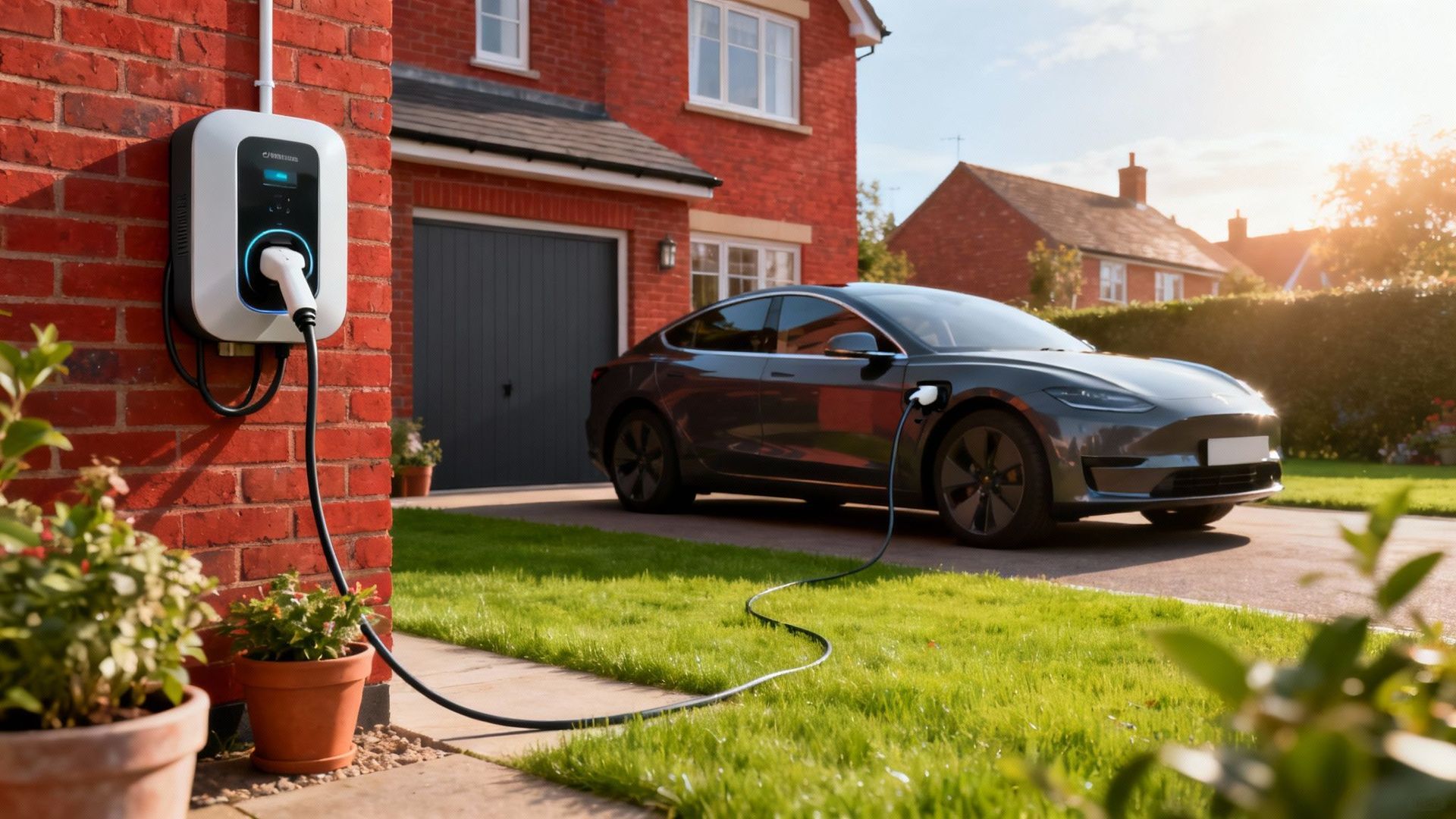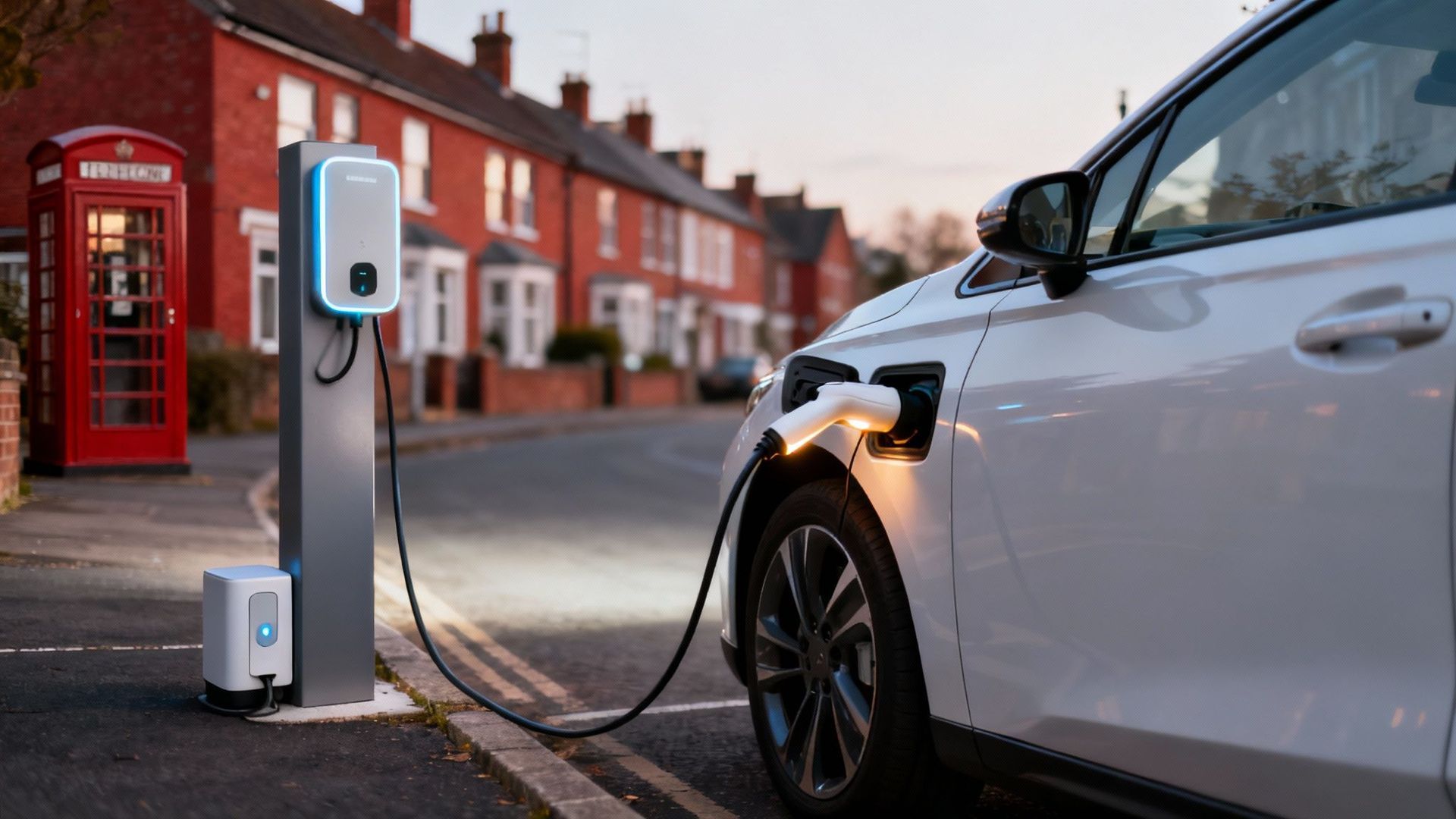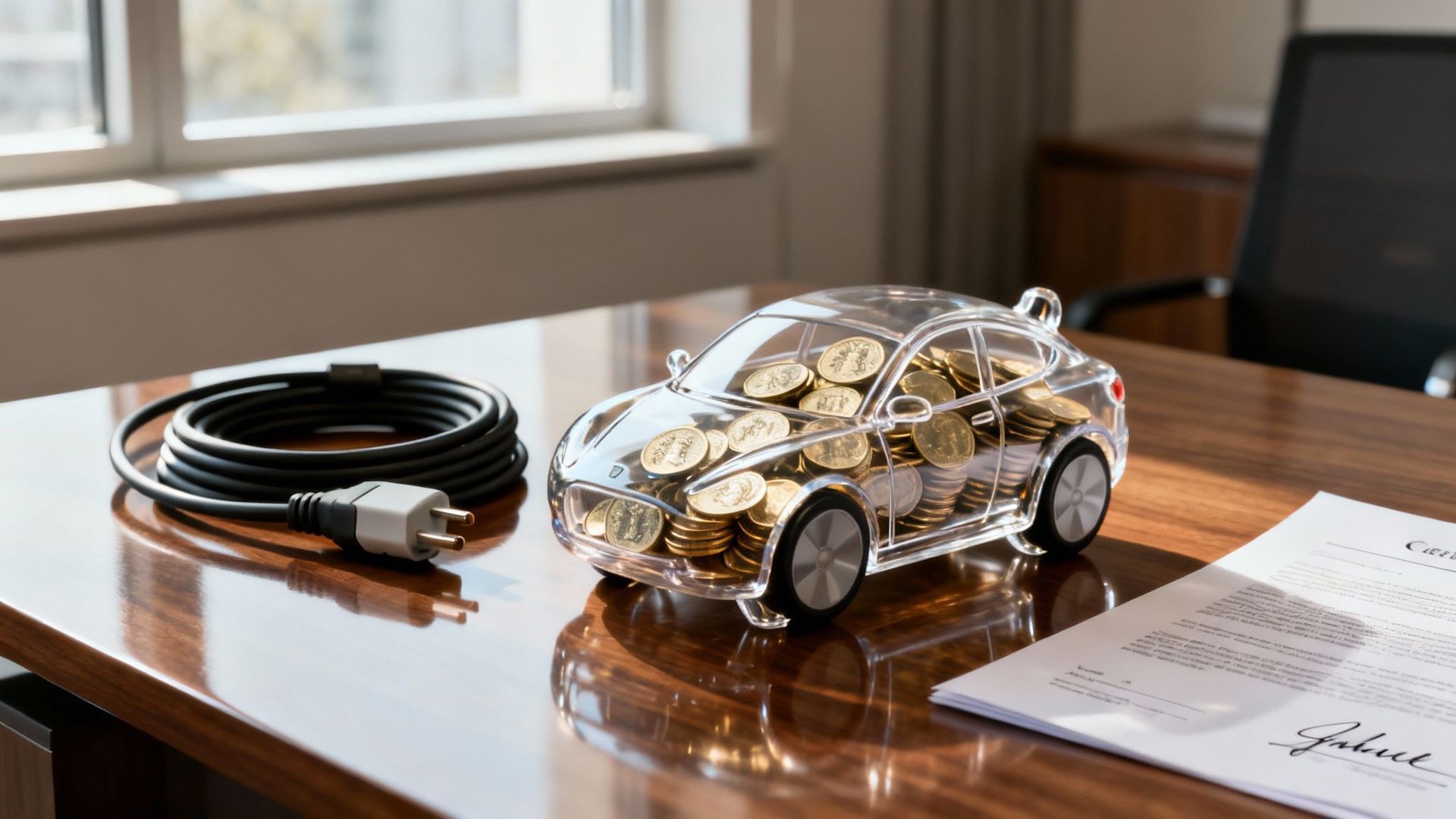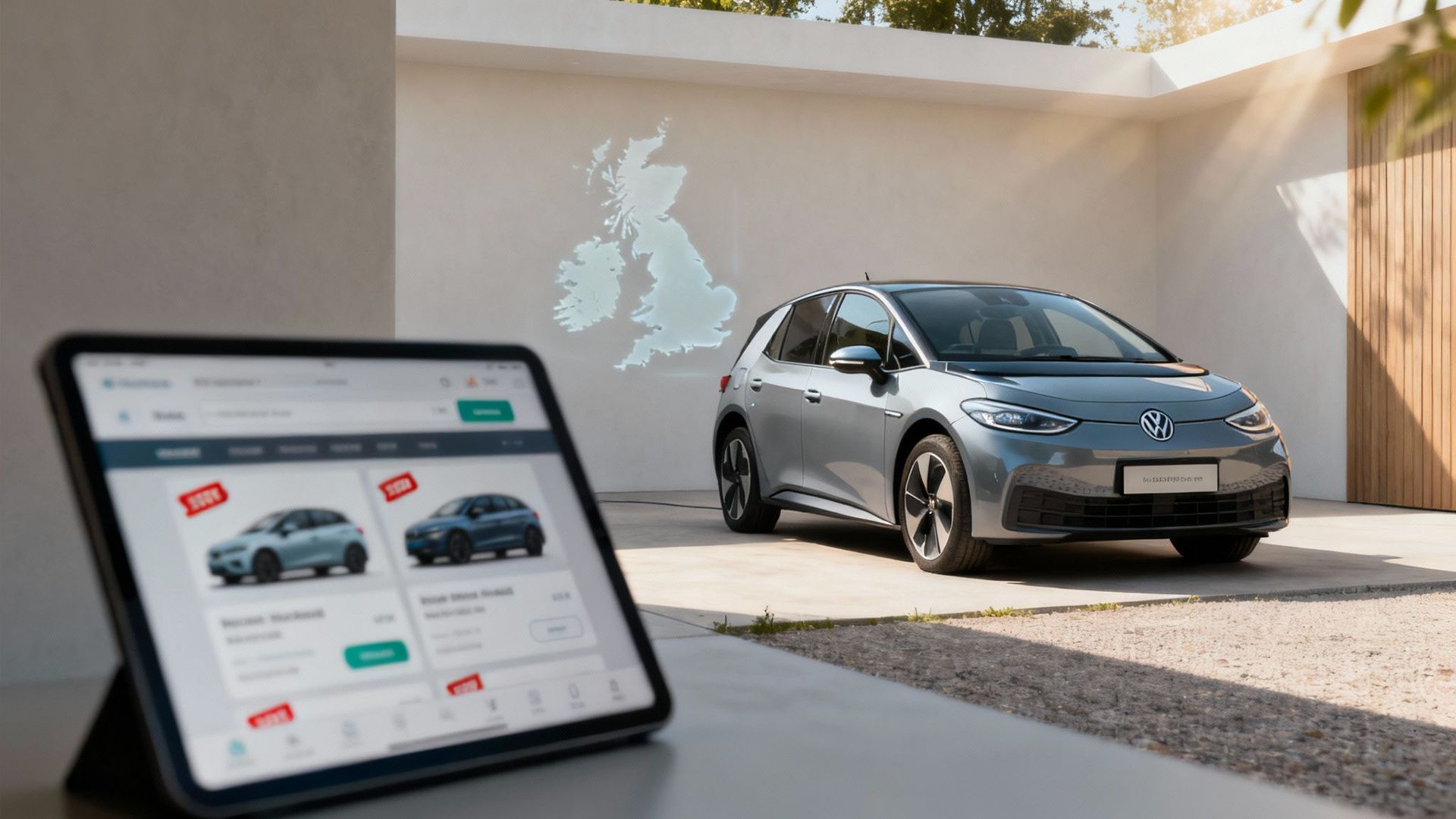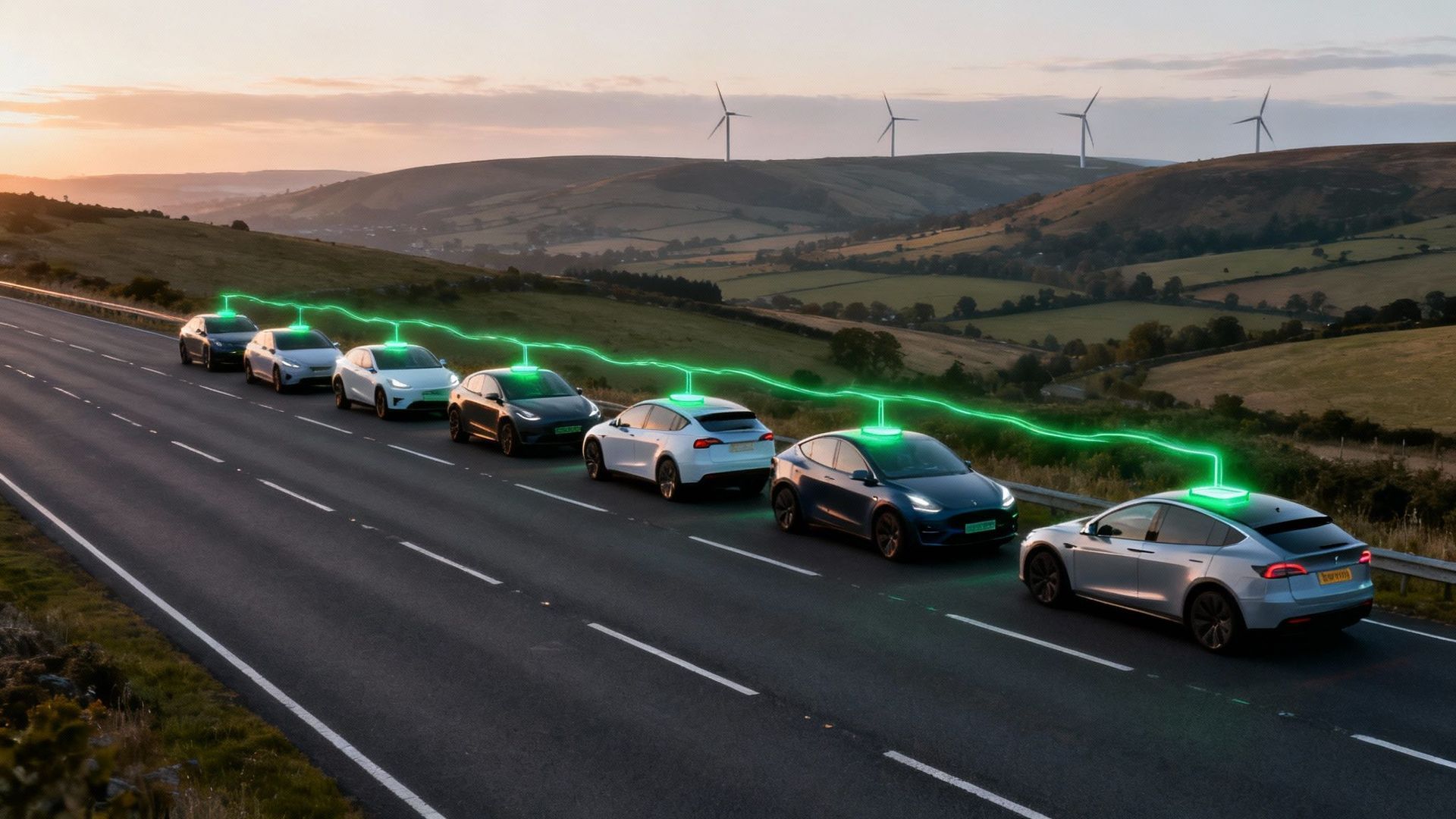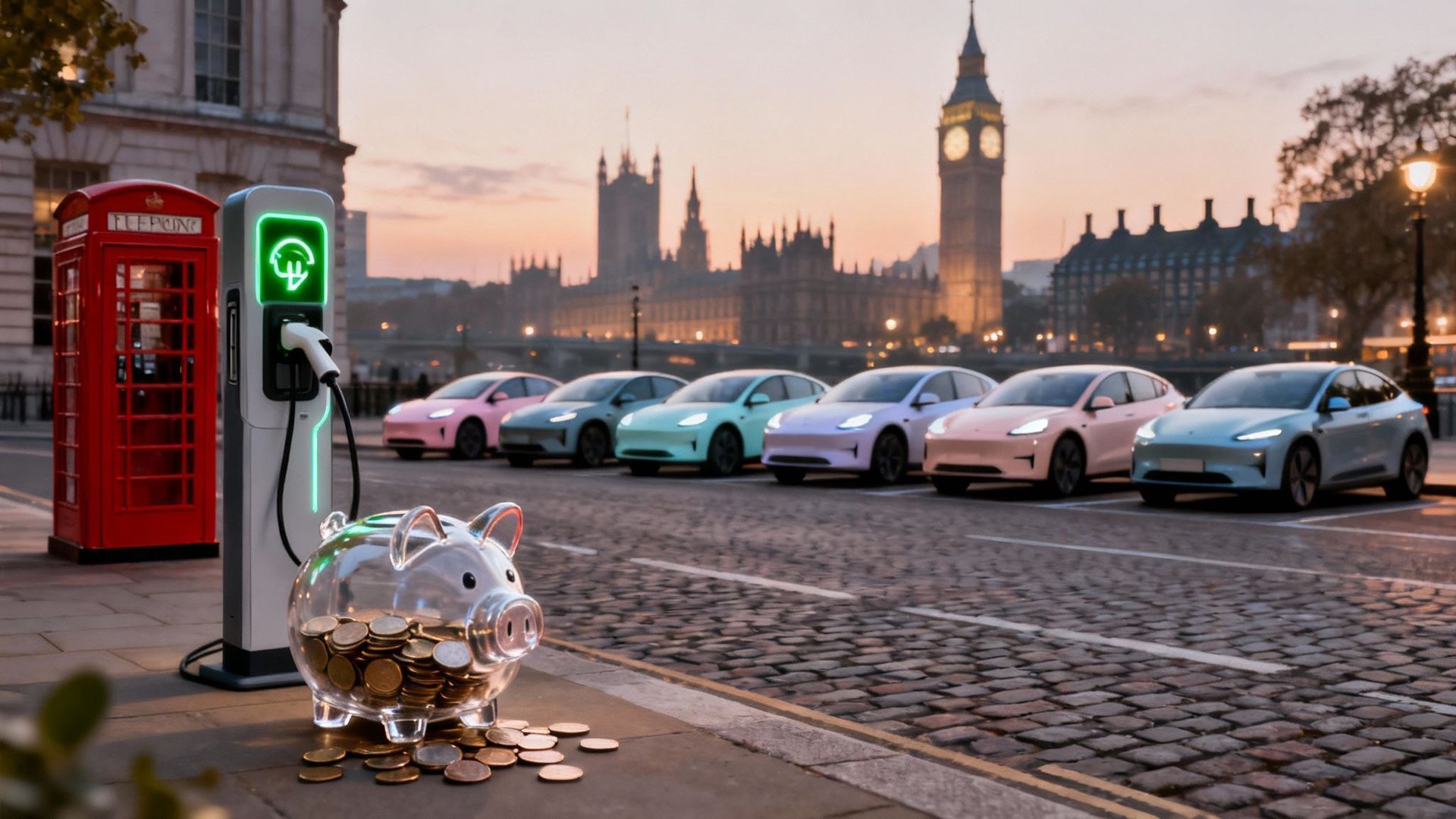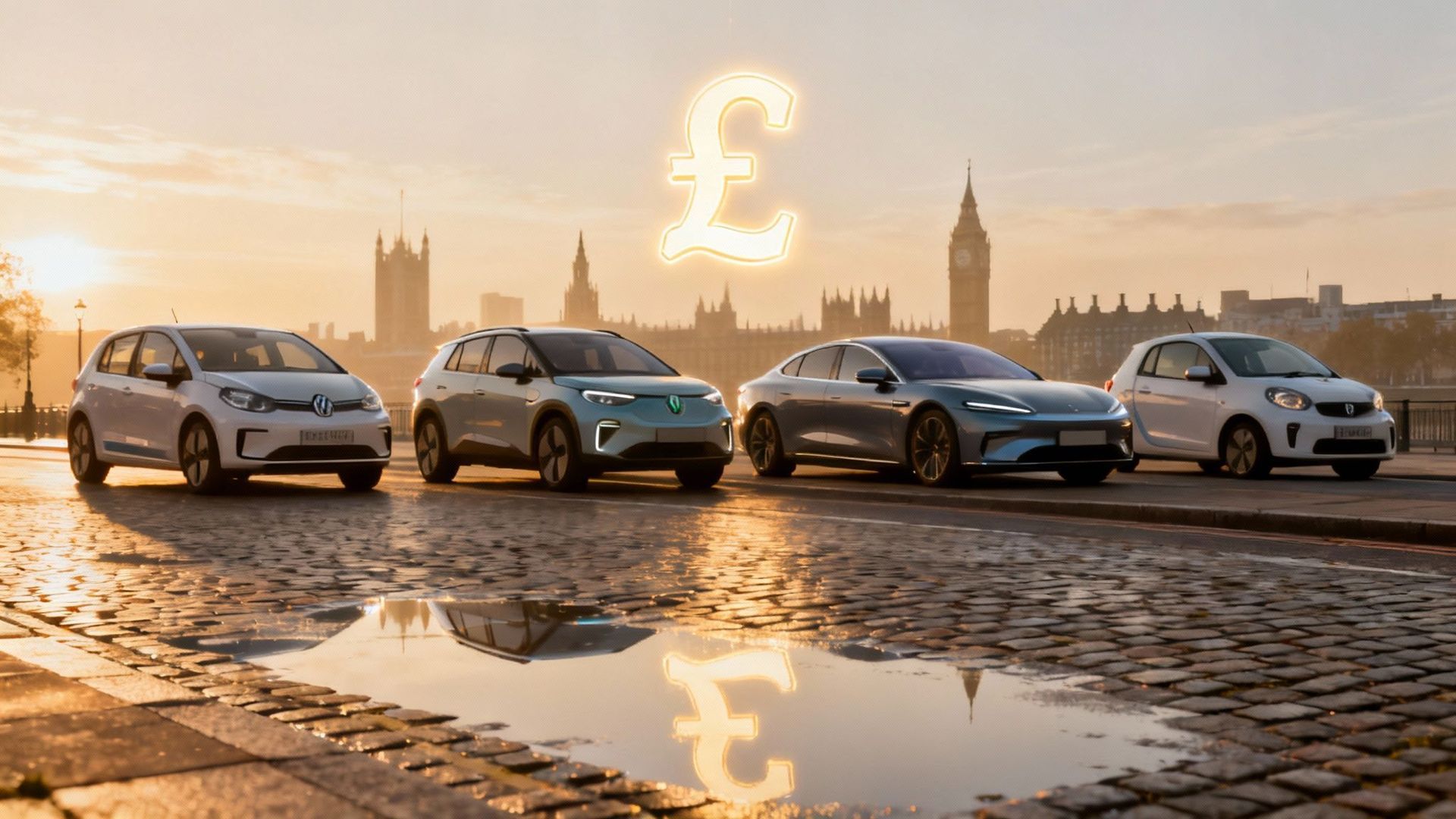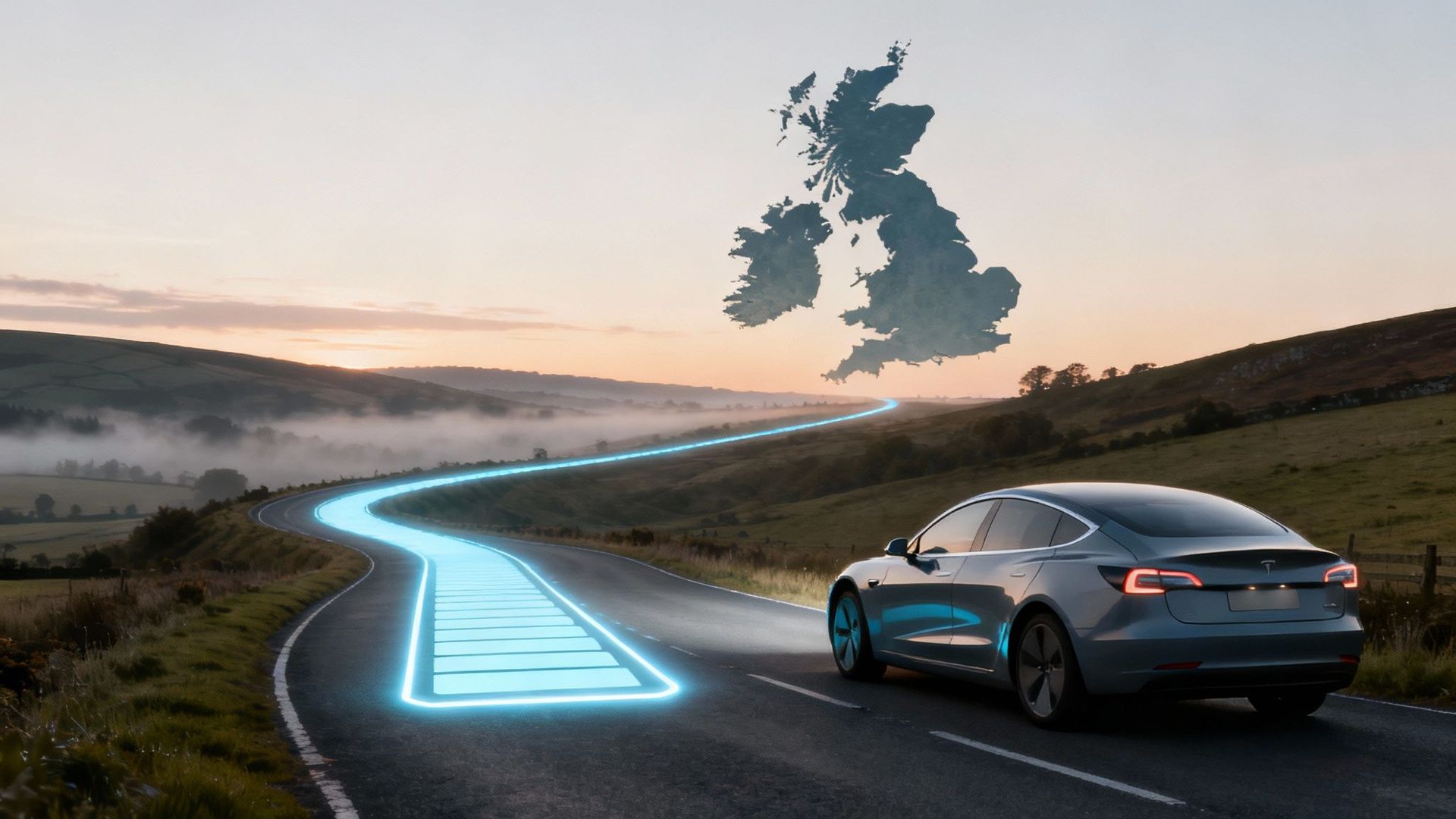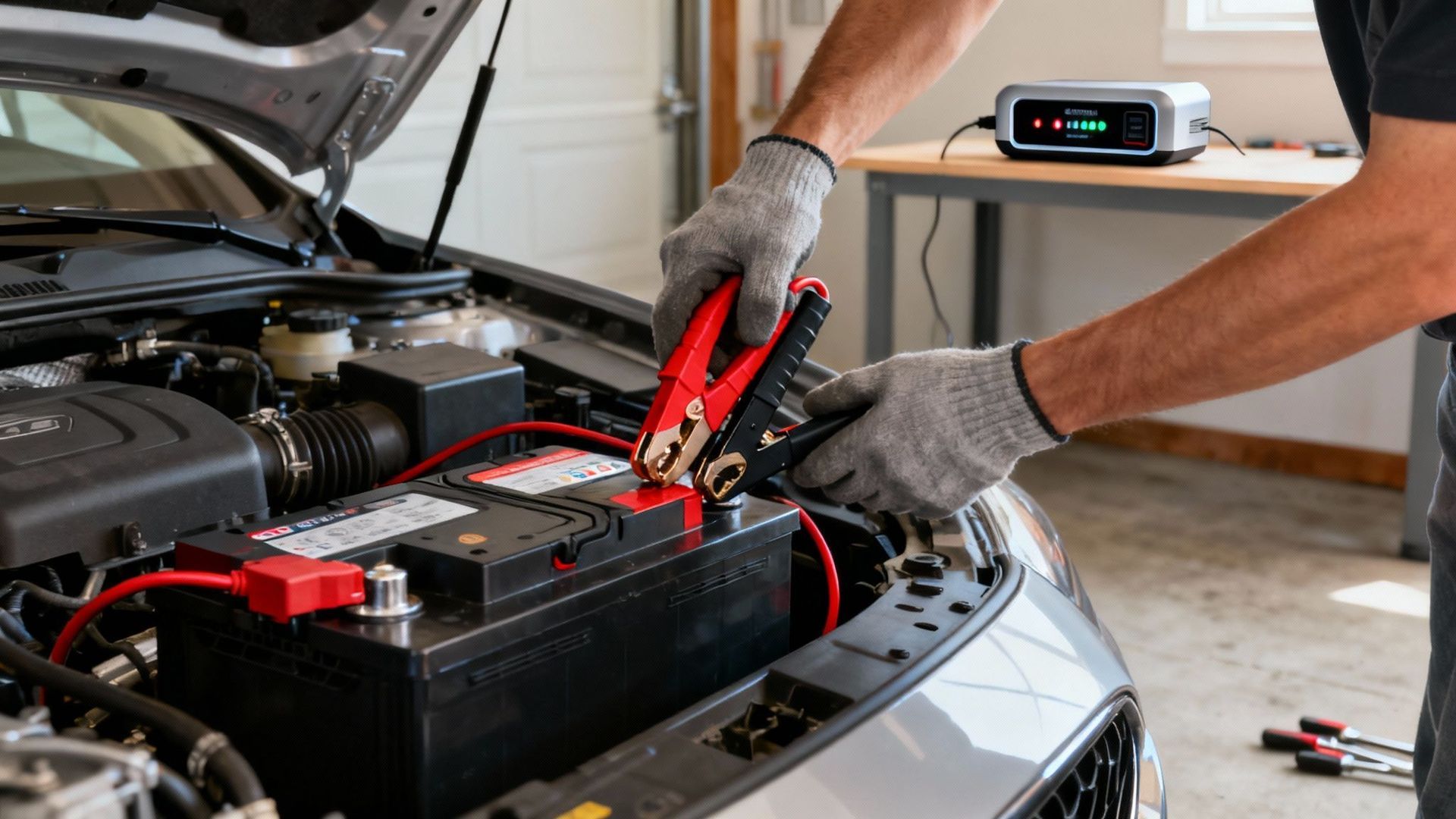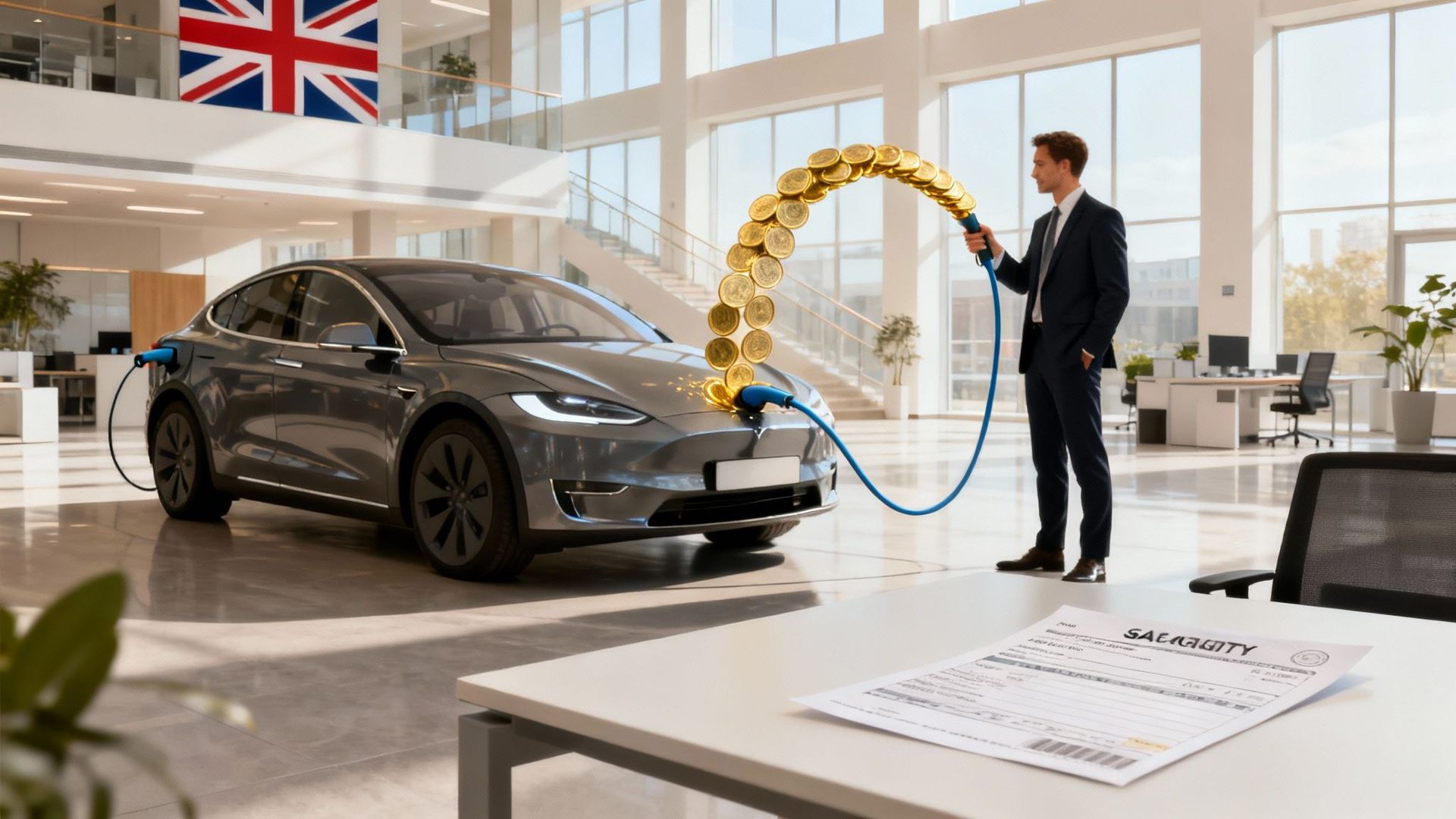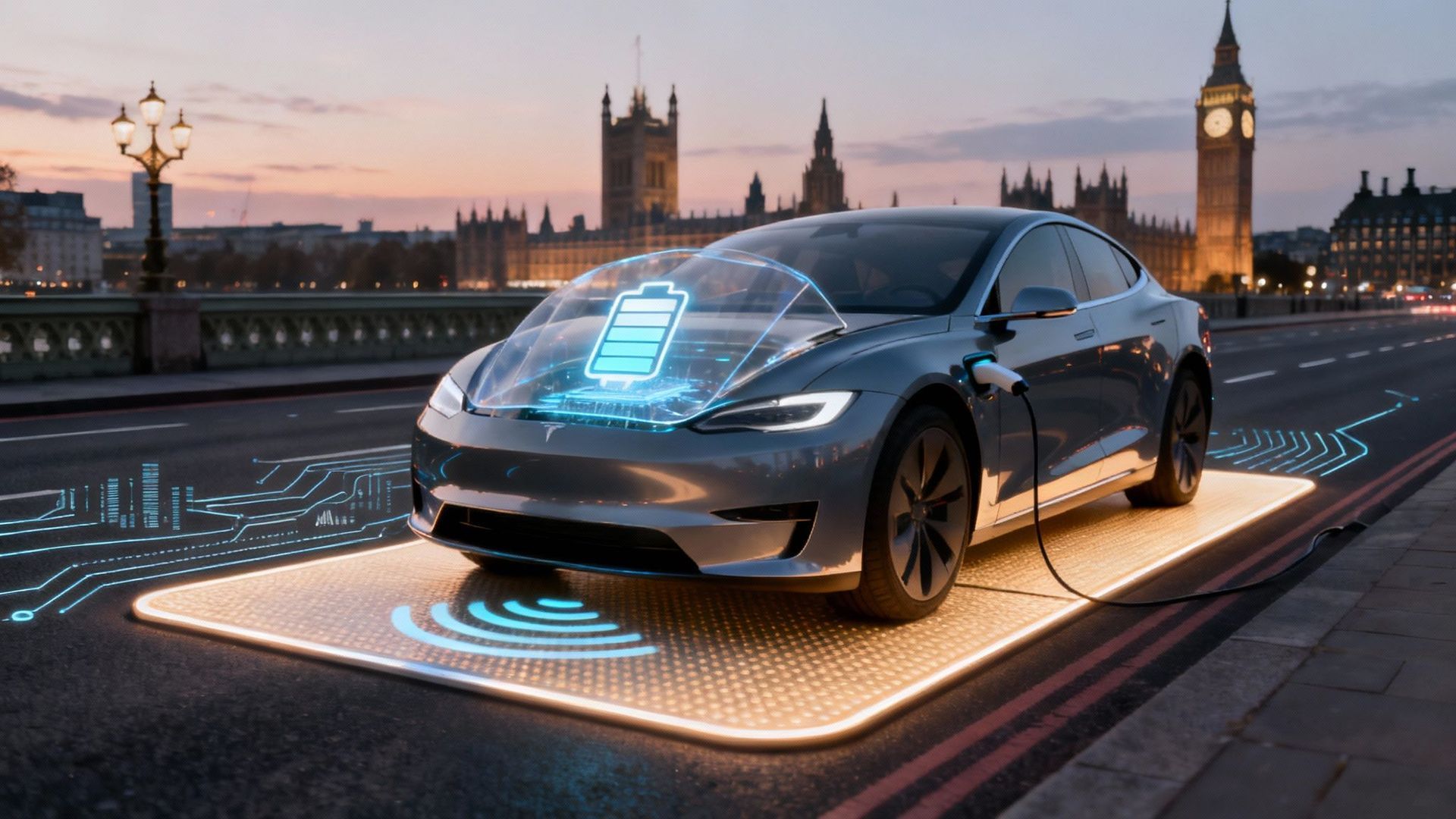BMW i8 Review: Is the Spaceship from 2014 Still a Future Classic?
Let's get one thing straight from the off. This isn't just another car review; it's a look back at a rolling concept sketch that somehow blagged its way onto UK roads. The BMW i8 is a carbon-fibre creation that still causes more rubbernecking than a lorry shedding its load on the M25. It occupies a strange, fascinating space between a genuine sports car and a breathtakingly pretty science project.
A Spaceship That Landed in 2014
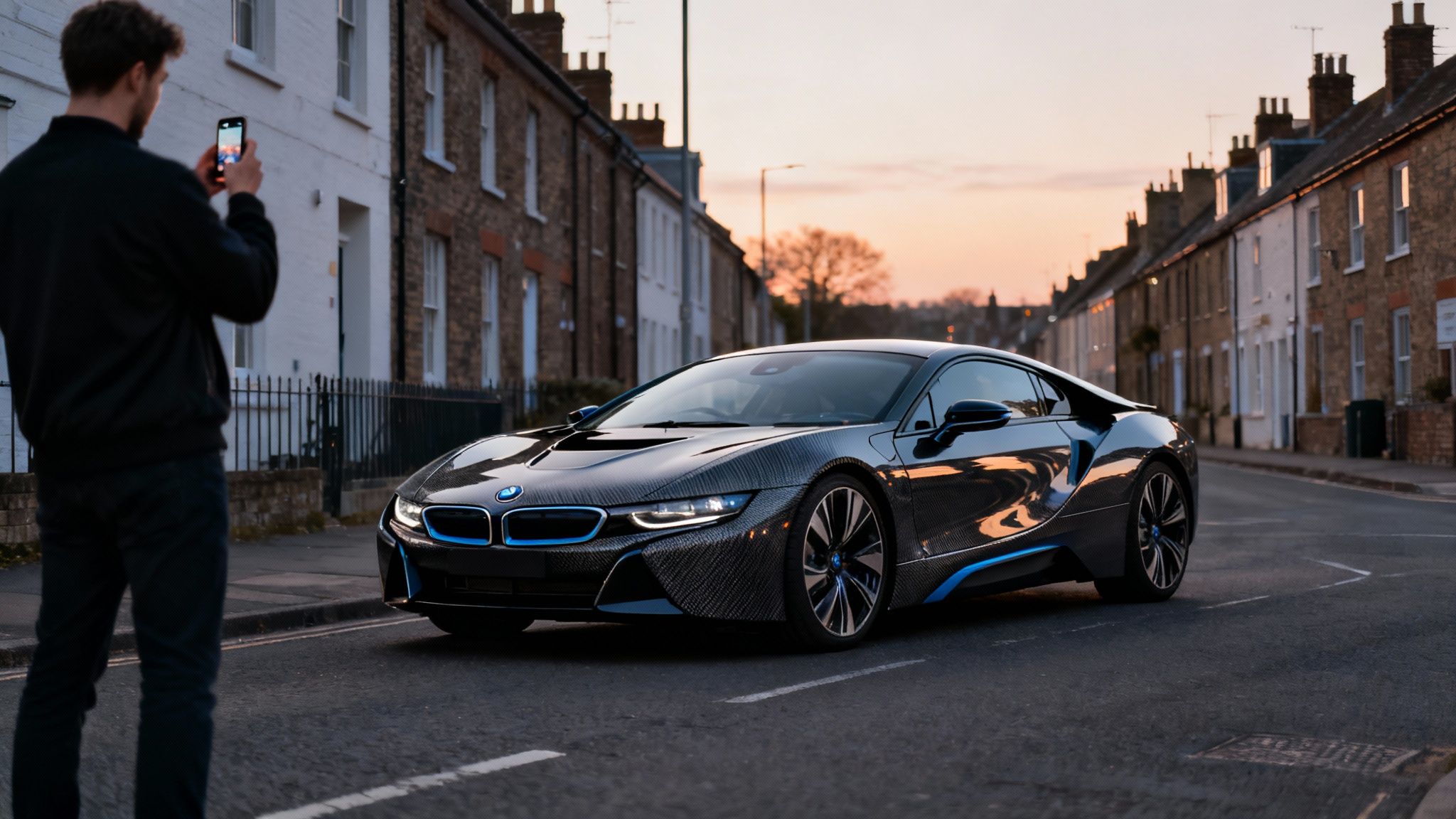
When the BMW i8 first appeared back in 2014, it felt less like a new model launch and more like someone had torn a hole in the space-time continuum. It was a vision of the future delivered a decade early, a machine so visually arresting it made everything else on the road look like it was designed by a committee armed with beige crayons. Its arrival was a proper event, signalling a bold, if slightly crackers, direction for performance cars.
This wasn't just another fast BMW. It was Munich's attempt to prove that "eco-friendly" and "exciting" weren't mutually exclusive ideas. The i8 landed as a plug-in hybrid halo car, a technological showcase designed to drag the perception of electrified motoring out of the slow lane. Its purpose was to make batteries and electric motors seem cool, and with those dihedral doors and flying buttresses, it absolutely looked the part.
An Instant Icon or Glorious Folly?
The car's impact was immediate. It was a statement piece, shouting about a new era by blending exotic materials with a powertrain that seemed utterly baffling at the time. Let’s be honest, the combination of a tiny three-cylinder petrol engine with an electric motor was just a bit weird. It left plenty of petrolheads scratching their heads, wondering if BMW had lost the plot entirely.
The i8 wasn't built to compete with a Porsche 911 on lap times. It was built to make a statement about the future, challenging the very definition of what a performance car could be in an age of growing environmental awareness.
Globally, BMW shifted over 5,456 units in 2015 alone , with total sales hitting more than 20,000 by 2020 . The UK proved to be a key European market for this futuristic machine, with the i8 helping to bolster BMW Group UK's record sales in 2014 as part of a much broader electrification strategy.
Beyond the Initial Shock
Years on, the i8 remains a fascinating case study. It was a true pioneer, a car that walked so that today’s all-electric supercars could run. It forced a conversation about sustainability in the high-performance sector, a discussion that continues to dominate the industry. You can explore more about this shift in our article on the rise of electric vehicles.
So, was the i8 a stroke of genius or just a glorious, ahead-of-its-time folly? Let’s find out.
A Concept Car for the Road
Let’s be clear: the BMW i8 doesn't just sit in a car park; it stages its own, silent motor show. It’s a jaw-dropping collection of swoops, channels, and layers that looks like it was sketched by someone who’d just binged the Blade Runner films. This isn’t just a car; it’s a piece of rolling sculpture that appears to be doing 100 mph even when it's perfectly still.
Every single line seems to have a purpose, or at least that’s the official story. Air is carefully guided over, under, and literally through the bodywork. Those wild-looking "stream flow" C-pillars aren't just for drama; they actually channel air over the rear to cut down on drag. It’s all part of an obsession with aerodynamics that results in a drag coefficient of just 0.26 – slipperier than a wet bar of soap.
The car sits impossibly low and wide, with a silhouette that could have been ripped from a teenager's most ambitious supercar doodle. It's a design that has aged brilliantly, mostly because it never looked like it belonged to any particular time. Even now, it turns more heads than brand-new supercars, which is saying something for a design that first hit the roads back in 2014.
The Glorious Trouble with Those Doors
And then you get to the doors. Oh, those doors. Officially, they’re called dihedral doors, and they swing upwards and forwards, creating a huge sense of theatre every time you get in or out. You don't just arrive in an i8; you make an entrance.
Of course, the reality of living with them in the UK is another matter entirely. They need a surprising amount of sideways space to open, which turns any tight spot in a Tesco multi-storey into your own personal nightmare. Getting out requires a move that’s half-gymnastics, half-contortion, as you negotiate a huge carbon-fibre sill before tumbling out with whatever dignity you have left.
Here's a quick rundown on how to exit an i8 with grace (spoiler: you can't):
- Step 1: Push the door up. Realise you've parked too close to a concrete pillar and it only opens halfway. Mutter something unrepeatable.
- Step 2: Swing one leg out and over the comically wide sill, trying to find solid ground.
- Step 3: Use your hand on the sill to hoist yourself up and out, praying you don't scuff the expensive carbon fibre or rip your trousers.
- Step 4: Emerge, slightly flustered, and pretend that's exactly how you meant to do it.
More Than Just a Pretty Face
Beneath that dramatic skin, there's some seriously clever engineering at play. The i8 is built using what BMW called its LifeDrive architecture . It's a fancy name, but the concept is brilliant: the car is split into two separate modules, the 'Life Module' and the 'Drive Module'.
The 'Life Module' is the passenger cell, made almost entirely from carbon-fibre-reinforced plastic (CFRP). This is the same high-tech, ultra-strong, and feather-light material used in Formula 1 cars.
This carbon-fibre tub forms the core of the car, giving it incredible rigidity and safety without piling on the pounds. Everything else—the petrol engine, electric motors, batteries, and suspension—is bolted to the aluminium 'Drive Module' below. This two-part construction is precisely why the i8, with all its hybrid tech, weighs less than 1,500 kg . This focus on lightweighting is fundamental to the car's whole character, and a point no BMW i8 review should ever skip over.
The Three-Cylinder Heart of a Supercar
Stick a 1.5-litre, three-cylinder engine in a car that looks like the i8, and you'd be forgiven for thinking it's a cruel joke. That's the sort of engine you’d find in a sensible little runabout, not something with doors that open up to the heavens. And yet, this tiny powerplant is the secret to the i8’s strange genius. It’s a beautifully bonkers idea that somehow, against all logic, just works.
The petrol engine is actually a seriously reworked version of the one from a Mini Cooper. By itself, it sends a respectable 228 bhp to the rear wheels. That might sound a bit limp for a supercar, but it’s only telling half the story. The other half comes from an electric motor driving the front wheels, chucking another 129 bhp into the mix.
When they join forces, you get a combined output of 357 bhp (later models saw this nudged up to 369 bhp ) and a clever, if slightly unorthodox, all-wheel-drive system. The car’s brain figures out where to send the power for the best result, making the petrol engine and electric motor perform a seamless, high-tech dance. It's this partnership between two wildly different power sources that truly defines the i8.
A Split Personality on Demand
The i8’s real party trick is how it can completely change its personality with the flick of a switch. You're not just getting one car; you're getting several, all depending on your mood. These driving modes aren't just for show either; they fundamentally change how the car feels and behaves.
-
eDrive Mode: This is full stealth mode. The car glides along using only its electric motor, giving you near-silent travel for up to 23 miles (or 34 miles in post-2018 models). It’s perfect for slipping out of your neighbourhood without waking anyone or cruising through town without burning a single drop of petrol. Of course, battery health is a big deal for this, and you can learn more about how long EV batteries really last in our detailed guide.
-
Comfort Mode: This is the i8's default state of mind. The car intelligently juggles the petrol engine and electric motor to give you the best blend of efficiency and performance. It’s smooth, quiet, and perfectly civilised for your daily commute.
-
Eco Pro Mode: This setting dials everything back to maximise efficiency. The throttle becomes less responsive, and the car does its best to stick to electric power, chasing that headline-grabbing 135 mpg figure. It looks fantastic on paper, but good luck getting anywhere near that in the real world.
-
Sport Mode: Now we're talking. Knock the gear lever to the left, and the i8 wakes up and gets angry. The digital dials glow red, the petrol engine snaps to life and stays on, the suspension firms up, and the steering gets a reassuring weight to it. The electric motor gives you that instant shove of torque to fill any gaps while the turbo spools, launching you from 0-62 mph in just 4.4 seconds .
This infographic gives you a visual breakdown of how the car's design helps this advanced powertrain do its job so well.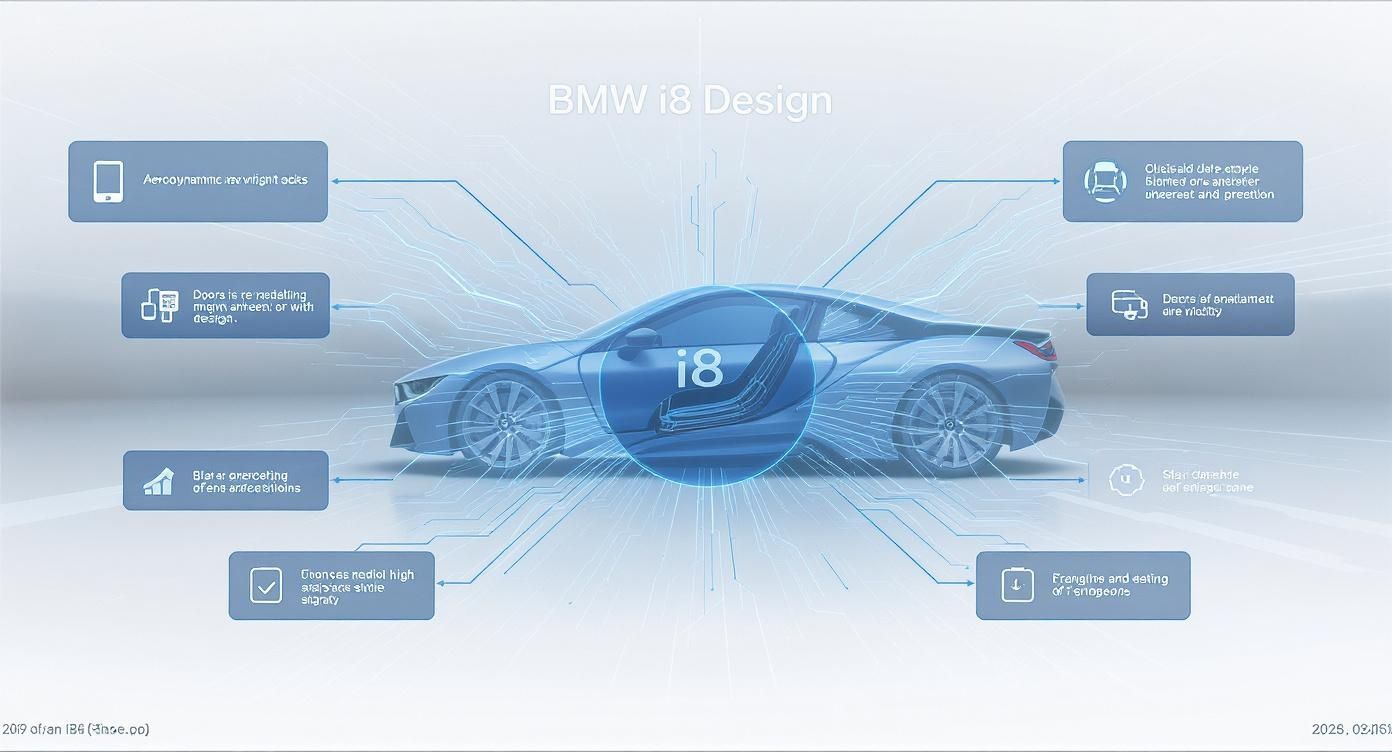 As the map shows, the lightweight chassis and slippery aerodynamics are absolutely key to getting the most out of the hybrid system's performance.
As the map shows, the lightweight chassis and slippery aerodynamics are absolutely key to getting the most out of the hybrid system's performance.
The Sound of Science
One of the most divisive things about the i8 has always been the noise it makes. Let's be honest, a three-cylinder engine doesn’t naturally sound like a fire-breathing supercar, so BMW’s engineers had to get a bit creative. In Sport mode, the car’s speakers pipe a synthesised, bass-heavy engine note into the cabin to dial up the drama.
Some purists cried foul, calling it fake and a cardinal sin in the performance car world. But others argue it’s just part of the i8's futuristic vibe—if the car is a vision of the future, why shouldn't it have a futuristic soundtrack?
Love it or loathe it, the sound is undeniably unique. It’s a deep, throaty warble that’s unlike anything else on the road. It adds a sense of occasion that the little three-pot engine couldn't possibly muster on its own, completing the car's transformation from a silent eco-warrior into a snarling, head-turning machine.
How the BMW i8 Actually Drives
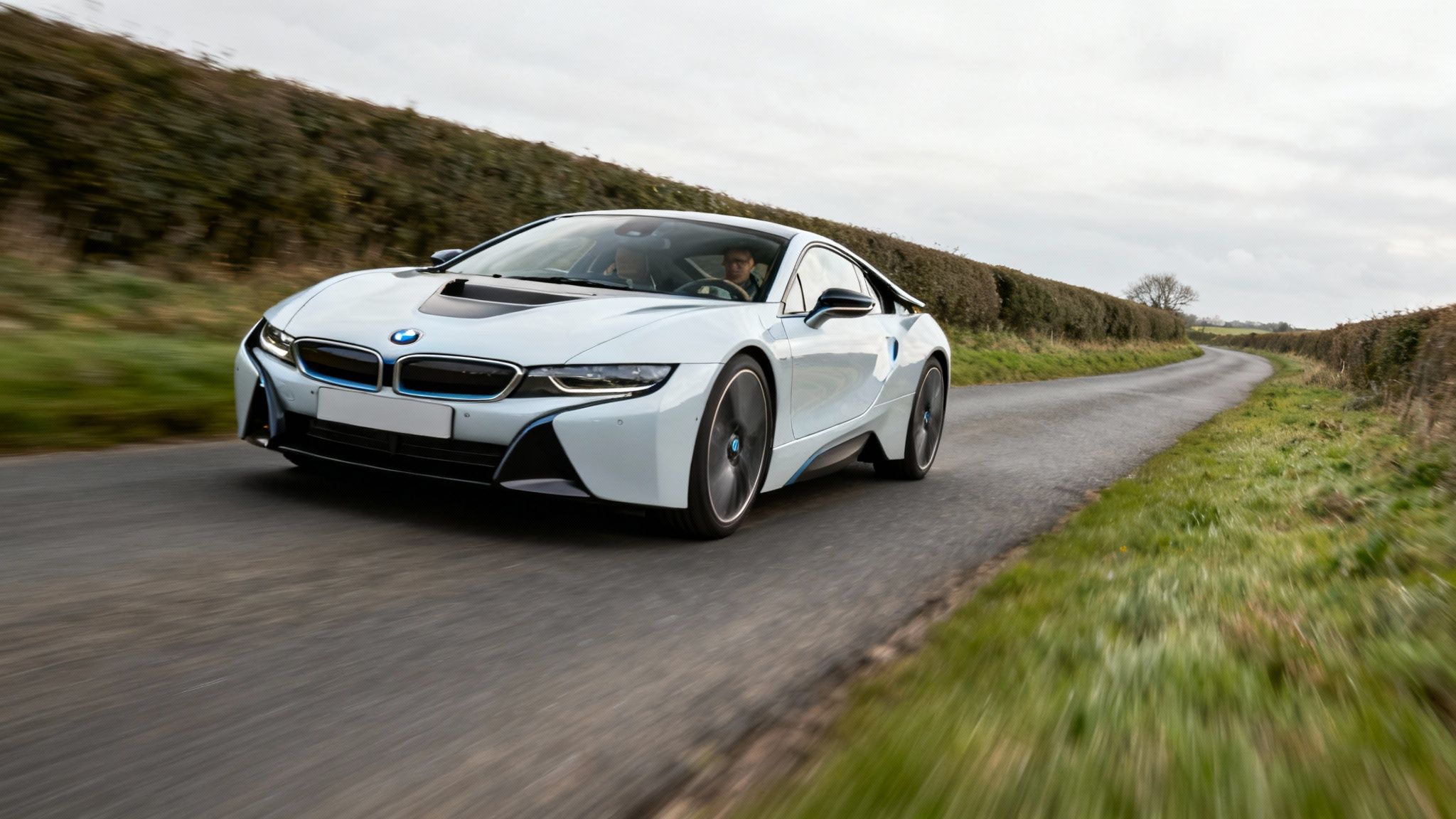
Right, let’s get down to the important bit. It has the looks of a concept car and the engine of a hot hatch, but what really happens when you introduce the i8 to a properly lumpy, pothole-scarred British B-road? Does the futuristic illusion shatter?
Surprisingly, not at all. But I will say this: it’s not the driving experience you might be expecting just by looking at it.
Once you’re settled behind the wheel, the first thing that hits you is how remarkably normal it all feels. In a good way. The driving position is classic BMW – absolutely spot-on. Visibility is far better than you’d think for something with such dramatic styling, and every control is exactly where you’d expect it to be. This isn’t some temperamental supercar that’s a nightmare to park; it’s as easy to potter around town in as a 3 Series.
In its default Comfort mode, the i8 plays the role of an accomplished grand tourer. The ride quality is astonishingly good, soaking up imperfections with a level of sophistication you just don’t see coming. On the motorway, it’s quiet, composed, and you could happily tick off hundreds of miles without feeling remotely beaten up. It’s a genuinely civilised and comfortable car.
The Jekyll and Hyde Switch
But then you flick the gear lever over into Sport mode. Instantly, the car’s personality cleaves in two.
The relaxed, eco-conscious cruiser completely vanishes. In its place is a snarling, eager performance car. The digital dials blaze red, a synthesised engine note (which sounds better than you might think) fills the cabin, and the whole car feels like it’s tensed up, ready for a proper thrashing.
This Jekyll-and-Hyde character is the i8’s party piece. It can be a silent, pure-electric city car one moment and a sharp, responsive sports car the next. The switch is dramatic and immediate, effectively giving you two very different cars for the price of one. Understanding this dual nature is central to ‘getting’ what the i8 is all about.
The i8 was never designed to be a track-day weapon to rival a Porsche 911. It's a vision of a futuristic GT, one that delivers a serious turn of speed without forcing you to sacrifice everyday comfort or your environmental conscience.
Let’s Talk About Those Tyres
One of the most talked-about, and often criticised, aspects of the i8 has always been its tyres. They're famously skinny. BMW chose them specifically to reduce rolling resistance and boost efficiency, but the immediate assumption was that they'd have all the grip of a wet fish.
In the real world, they hang on far better than you’d ever believe.
Thanks to the car's clever all-wheel-drive system and incredibly low centre of gravity, you can carry a surprising amount of speed through corners. The steering is direct and has a pleasing weight to it, giving you the confidence to press on. It feels wonderfully agile, changing direction with real eagerness—a direct benefit of its lightweight carbon-fibre construction. You have to be driving like an absolute hooligan to find the limits of its front-end grip.
For 99% of driving on public roads, the grip is more than enough. The i8 feels planted and secure, darting through bends with an enthusiasm that completely belies its eco-friendly mission statement.
The Peculiarities of Performance
Driving the i8 quickly does reveal a few quirks you need to get your head around. The brakes, for one, have a slightly odd feel underfoot. Like many hybrids, the i8 uses regenerative braking to capture kinetic energy and top up the battery whenever you slow down.
This means the initial press of the pedal can feel a little disconnected as the car’s brain decides whether to use regeneration or the traditional mechanical brakes. They’re plenty powerful when you really stand on them, but they lack the progressive, intuitive feel you get from a conventional performance car.
Here’s a quick summary of how it behaves on the road:
- Agility: Excellent. The car feels light and nimble, changing direction with impressive speed.
- Ride Comfort: Superb. It’s far more comfortable and forgiving than its supercar looks would suggest.
- Steering: Direct and nicely weighted, though it's not fizzing with the last degree of feedback.
- Braking: Powerful when you need it, but the regenerative system takes some getting used to.
Ultimately, the BMW i8 serves up a driving experience that’s as unique and multi-layered as its design. No, it isn't a raw, analogue driver’s car in the traditional sense. What it is, however, is an incredibly capable, genuinely fast, and thoroughly engaging machine that still feels like a fascinating glimpse into the future of performance motoring.
So, What's the Real Cost of Owning an i8 in the UK?
Alright, so you've seen the photos, fallen for those incredible doors, and now you find yourself casually scrolling through the classifieds. This is the danger zone. Picking up a used BMW i8 feels like a wonderfully tempting way to get a slice of the future for a bargain, but keeping one on the road? That's a completely different kettle of very expensive, very complicated fish.
Let's be brutally honest here. When it was brand new, the i8 came with a price tag well north of £100,000 . Thanks to the wonderful, terrifying magic of depreciation, you can now put that spaceship on your driveway for a fraction of that. But while the initial price might seem manageable, the potential for eye-watering repair bills is very, very real.
This isn't the kind of car you can pop down to your local garage to have Dave give it a quick once-over. The i8 is a hugely complex machine, built with exotic materials and a hybrid powertrain that demands specialist knowledge. It's less like owning a car and more like being the custodian of a temperamental piece of high-tech art.
Finding a Gem in the Used Market Minefield
A quick search of the UK market shows a fascinating spread. The i8’s residual values have actually held up surprisingly well, with used examples typically going for anything between £30,000 and £102,000 . The final price tag really depends on the year, mileage, and its overall condition.
At the lower end of the scale, you’re looking at the early 2014-2015 cars, often with higher mileage, that have clearly been well-loved and thoroughly enjoyed. At the top end, you'll find pristine, last-of-the-line Roadster models with barely any miles on the clock. You can learn more about the i8's market performance and technical specs on Autocar.co.uk.
When you're looking at a potential buy, a full BMW service history isn't just a "nice to have"—it's an absolute must. Pay incredibly close attention to the health of the battery pack and the state of the carbon-fibre bodywork. A minor bump that would be a simple, cheap fix on a normal car could easily turn into a specialist repair bill running into thousands of pounds on an i8.
Typical UK Used BMW i8 Price Guide
To give you a clearer picture, here's a snapshot of what you can expect to pay for a used i8 in the UK right now. Prices fluctuate, of course, but this should give you a solid starting point.
| Model Year | Typical Price Range (£) | Key Considerations |
|---|---|---|
| 2014-2015 | £30,000 - £45,000 | Early models. Check battery health and service history meticulously. Higher mileage. |
| 2016-2017 | £45,000 - £60,000 | Mid-life examples. Often better specified. A good balance of price and condition. |
| 2018-2020 | £60,000 - £80,000+ | Facelift models and Roadsters. Lower mileage, better tech, and higher prices. |
Remember, these figures are just a guide. A low-mileage, perfectly maintained 2015 car could easily be a better buy than a neglected 2017 model, so always judge each car on its own merits.
The Mythical MPG and Real-World Running Costs
Now, about that headline figure BMW loved to shout about: 135 miles per gallon . Let's be clear, in the real world, you're about as likely to hit that number as you are to find a unicorn grazing in your back garden. That figure was a product of an old, outdated testing cycle that gave a huge advantage to plug-in hybrids.
To get anywhere near it, you’d have to do almost all of your driving on short trips, starting with a fully charged battery every single time. The second that little three-cylinder petrol engine kicks in, your fuel economy drops like a stone. Most owners report a far more realistic average of around 40-50 mpg in mixed driving – which, to be fair, is still seriously impressive for a car with this kind of performance.
Owning an i8 is a serious financial commitment that goes way beyond the fuel pump. Servicing at a BMW main dealer is expensive, and if a major component like the hybrid system fails outside of its warranty, you're staring down a bill that could comfortably buy you a decent second-hand hatchback.
Here’s a quick rundown of what to budget for:
- Servicing: Expect to pay significantly more for a main dealer service than you would for a conventional BMW.
- Tyres: Those skinny, bespoke tyres don't come cheap when it's time to replace them.
- Insurance: Insurers see a supercar, so you can expect the premiums to match that perception.
- Repairs: This is the big one. An out-of-warranty repair on the hybrid system or the carbon-fibre chassis can be financially ruinous.
It's vital to weigh these costs up. The day-to-day expenses might catch you by surprise, and it's worth reading our guide on the real cost of owning an EV compared to petrol cars for a wider perspective. While the i8 isn't a full EV, many of the same principles about specialised maintenance apply. The BMW i8 offers a truly unique ownership experience, but it’s one you should definitely enter with your eyes, and your wallet, wide open.
A Few Lingering Questions About the BMW i8
You’ve made it this far, so I'm guessing you're either seriously tempted or just morbidly curious. Either way, you've probably got a few questions buzzing around. Let's tackle some of the most common ones I hear about the i8, without any of the usual guff.
Is the BMW i8 a Real Supercar?
Let's get this sorted once and for all. Does it have the looks? Without a doubt. This car turns more heads than a winning lottery ticket. Does it have the performance? Well, yes and no. A 0-62 mph time of 4.4 seconds is seriously quick, and from a standing start, it'll leave plenty of traditional V8-powered sports cars wondering what just happened.
But if you're thinking of raw, top-end, track-day power, it's not playing in the same sandbox as a Ferrari or a Lamborghini. I like to think of it as a modern-day supercar. It’s got all the visual drama and instant acceleration you could want, but it doesn’t come with the anti-social soundtrack or eye-watering fuel bills. It's a different, much cleverer kind of fast.
Is It an Electric Car or a Petrol Car?
It’s both. The i8 is what’s known as a plug-in hybrid (or PHEV). Underneath that wild bodywork, you’ll find a small petrol engine—a tiny 1.5-litre , three-cylinder unit, in fact—paired with an electric motor. They can work on their own or team up for maximum punch.
You can plug it into the wall and charge the battery, which on later models gives you up to 34 miles of pure, silent, electric-only driving. Perfect for the daily commute. When the battery gets low, or you put your foot down, the petrol engine seamlessly kicks in to assist. It’s a brilliant setup that gives you the best of both worlds: zero-emission city driving and the freedom to cross the country without a hint of range anxiety.
Are Those Rear Seats Actually Usable?
For actual human beings? Not really. Not unless they're children, contortionists, or perhaps just imaginary friends. The i8 is technically a 2+2, which in car-designer language usually means, "two proper seats up front and two beautifully sculpted hollows in the back for… well, we're not sure."
Think of the rear seats as an extension of the boot. They're perfect for a couple of weekend bags or stashing your jacket, but trying to squeeze an adult back there would be a deeply unfriendly thing to do.
If you regularly need to carry more than one passenger, you'll need to look elsewhere. The i8 is really a car for you and one very lucky companion.
How Much Does It Cost to Charge?
This is where the i8 starts to make a surprising amount of financial sense. Charging its relatively small battery ( 7.1 kWh on early cars, 11.6 kWh on post-2018 models) is laughably cheap compared to filling a conventional sports car with super unleaded.
If you charge at home on an off-peak electricity tariff, a full top-up will genuinely cost you less than a fancy coffee. From a standard three-pin socket, you’re looking at about three hours. Get a proper home wallbox installed, and that drops to under two. It’s this blend of thrilling performance and low running costs that really defines the long-term ownership experience.
Is It a Reliable Car?
And here it is. The big, slightly scary question. There's no getting around the fact that the i8 is a phenomenally complex machine. You've got a turbocharged petrol engine, electric motors, high-voltage batteries, and a carbon-fibre chassis all working in harmony. When it works, it's magical. When it doesn't, you'll be very glad you have a comprehensive warranty.
Early cars did have some well-documented niggles, especially with things like the air-conditioning compressor. Most of these should have been fixed under warranty by now, but you absolutely must insist on a full BMW service history. The key is to find a cherished example. It's not that the i8 is fundamentally unreliable, but its complexity means that when things do go wrong, the fixes are rarely cheap.
So, Should I Actually Buy One?
Look, if you want a rational, sensible car for the daily grind, this probably isn't it. But you don't buy a car that looks like it's just driven off a film set for sensible reasons. You buy an i8 because it makes you feel like you're driving something from the future. You buy it for the theatre, the head-turning looks, and the sense of occasion you get every single time you lift those incredible doors.
This is a car that makes a statement. It’s proof that high performance and genuine efficiency can live together in one stunning package. If you understand what it is—a futuristic grand tourer, not a hardcore track weapon—and you go in with your eyes open to the potential running costs, the BMW i8 is one of the most special and rewarding cars you could ever own. It was ahead of its time when it launched, and honestly, it still feels like a visitor from the future today.
At VoltsMonster , we cut through the noise to bring you honest, entertaining reviews and insights into the world of electric and hybrid vehicles. If you're navigating the future of motoring, check out more of our content at https://www.voltsmonster.com.

